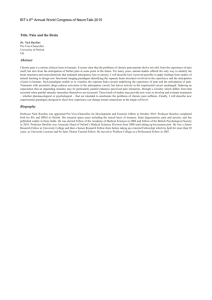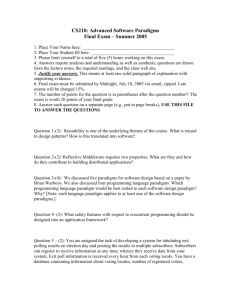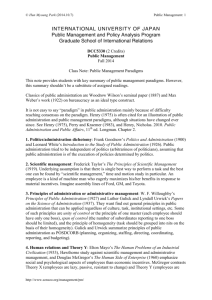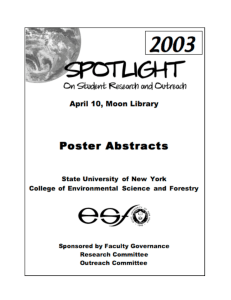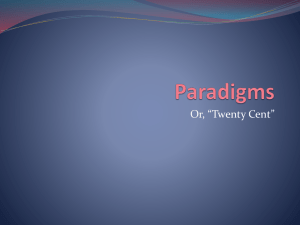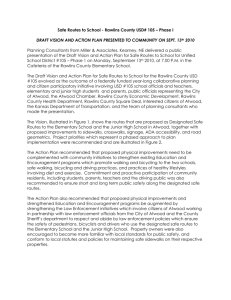Leading Communities: Changing Paradigms and Earning Employee Allegiance
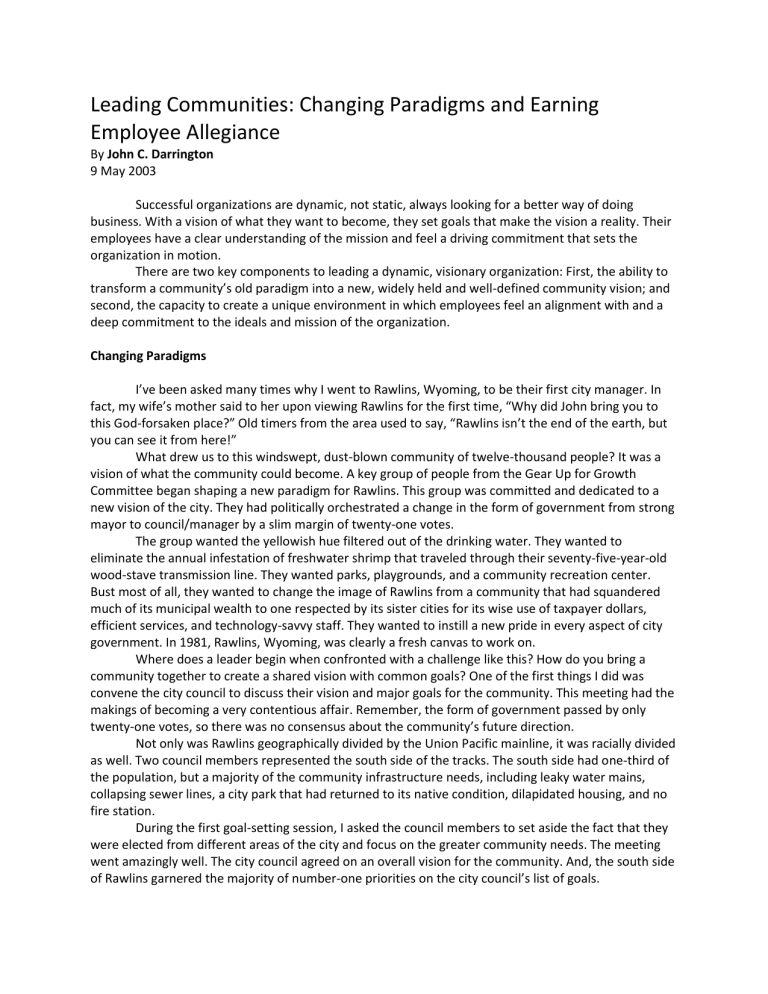
Leading Communities: Changing Paradigms and Earning
Employee Allegiance
By John C. Darrington
9 May 2003
Successful organizations are dynamic, not static, always looking for a better way of doing business. With a vision of what they want to become, they set goals that make the vision a reality. Their employees have a clear understanding of the mission and feel a driving commitment that sets the organization in motion.
There are two key components to leading a dynamic, visionary organization: First, the ability to transform a community’s old paradigm into a new, widely held and well-defined community vision; and second, the capacity to create a unique environment in which employees feel an alignment with and a deep commitment to the ideals and mission of the organization.
Changing Paradigms
I’ve been asked many times why I went to Rawlins, Wyoming, to be their first city manager. In fact, my wife’s mother said to her upon viewing Rawlins for the first time, “Why did John bring you to this God-forsaken place?” Old timers from the area used to say, “Rawlins isn’t the end of the earth, but you can see it from here!”
What drew us to this windswept, dust-blown community of twelve-thousand people? It was a vision of what the community could become. A key group of people from the Gear Up for Growth
Committee began shaping a new paradigm for Rawlins. This group was committed and dedicated to a new vision of the city. They had politically orchestrated a change in the form of government from strong mayor to council/manager by a slim margin of twenty-one votes.
The group wanted the yellowish hue filtered out of the drinking water. They wanted to eliminate the annual infestation of freshwater shrimp that traveled through their seventy-five-year-old wood-stave transmission line. They wanted parks, playgrounds, and a community recreation center.
Bust most of all, they wanted to change the image of Rawlins from a community that had squandered much of its municipal wealth to one respected by its sister cities for its wise use of taxpayer dollars, efficient services, and technology-savvy staff. They wanted to instill a new pride in every aspect of city government. In 1981, Rawlins, Wyoming, was clearly a fresh canvas to work on.
Where does a leader begin when confronted with a challenge like this? How do you bring a community together to create a shared vision with common goals? One of the first things I did was convene the city council to discuss their vision and major goals for the community. This meeting had the makings of becoming a very contentious affair. Remember, the form of government passed by only twenty-one votes, so there was no consensus about the community’s future direction.
Not only was Rawlins geographically divided by the Union Pacific mainline, it was racially divided as well. Two council members represented the south side of the tracks. The south side had one-third of the population, but a majority of the community infrastructure needs, including leaky water mains, collapsing sewer lines, a city park that had returned to its native condition, dilapidated housing, and no fire station.
During the first goal-setting session, I asked the council members to set aside the fact that they were elected from different areas of the city and focus on the greater community needs. The meeting went amazingly well. The city council agreed on an overall vision for the community. And, the south side of Rawlins garnered the majority of number-one priorities on the city council’s list of goals.
Significant changes occurred because of the goals and new vision. Within four years, six parks and playgrounds were either constructed or reconstructed, a new first station was built on the south side, housing rehabilitation grants were secured, and the city accounting and utility billing system became fully automated.
However, the greatest achievement for the council was their newfound ability to articulate with one voice and enunciate one vision to the five top elected officials of the state. Conveying one clearly defined vision got impressive results and helped the city secure grants from the state’s substantial infrastructure account to address critical city needs.
Members of the state executive departments had invited me to the state capital in Cheyenne at the beginning of my tenure to express their frustrations working with Rawlins. Before being hired by
Rawlins, projects were submitted for grant funding without regard or coordination with other applications, creating a disjointed and fragmented approach. The message from state executives was,
“Give us a unified vision of what you need to accomplish, and we will provide the assistance the state has to make it happen.”
The results of speaking with one voice were quite impressive. Each year when the freshwater shrimp infested the water system the city became the subject of unfavorable news articles across the country. The city council used this negative media coverage to convince the state it needed assistance building a water filtration plant. It worked! A water treatment plant was constructed to eliminate the yellowish colored water and the shrimp. The state granted half the capital construction money. Within seven to eight years, the state of Wyoming also funded 60 percent of the replacement costs for the seventy-five-year-old, twenty-six-mile, wood-stave pipeline. That was progress!
The ability to form a unified voice and make significant progress in a community starts with a leader or group of leaders who analyze the past as they contemplate the future. They consider the history and traditions, unique physical characteristics, nature and driving force of the economy, and the core community values. They capture in words their dreams and ambitions for a renewed community, bearing in mind what they want to bequeath to the next generation. Warren Bennis said, “In the end, the leader may be the one who articulates the vision and gives it legitimacy, who expresses the vision in captivating rhetoric that fires the imagination and emotions of followers, who through the vision empowers others to make decisions that gets things done.” i
A wise city manager discovers early on the community’s vision for the future and, if it has not been developed fully, orchestrates the process to bring it about. It’s the manager’s job to help the city council understand a city is more than a series of connecting streets that share a common water and sewer system dotted by an occasional park or playground. Instead, it is a dynamic laboratory where paradigms are changed, where diverse individual dreams, ambitions, and economic interests are intertwined in a community fabric called “vision.”
Earning Employee Respect
An excellent leader will not only help break paradigms and instill vision but also find a way to earn the respect and win the heart and soul of the people who work in public organizations. Public employees don’t have the same tools a private company has to motivate people. A public employee cannot earn an equity interest in the company nor receive shares or dividends, six figure bonuses, or trips to exotic places. The public’s business is conducted under a unique set of rules and ethical considerations.
The key to developing a unique environment which employees have a deep-seated commitment to the ideals and mission found in some organizations is summarized in the words of Mark Willes, former chair and CEO of Times Mirror Company:
People will work for money, but they will die for something they believe in deeply. They will give their all for a cause to which they are committed. If a leader is to lead, he or she must kindle the passion of the organization, give energy rather than take it away, and help people feel purpose.
ii
In a session with a group of employees in Gillette, Wyoming, we brainstormed the characteristics of an exceptional organization. The list establishes a high watermark for any organization.
The characteristics are:
Trust: Create an atmosphere of complete trust.
A clear mission : Know where you are going and why you exist.
Innovation : Think outside the box.
Honesty : Make your word your bond, and don’t speak for others without their permission.
Competence : Know your business.
Listening : Listen to customers and employees.
Flexibility : Come up with individualized solutions to problems, no “one size fits all.”
Motivation : Have a desire to succeed.
Responsibility : Depend on people to do their jobs and take ownership of mistakes.
Global view : Share vision and common goals with all employees.
Fun atmosphere : Create an element of playfulness in the workplace.
Challenging environment : Foster new ideas and solutions.
Consistency : Send the same message to public and employees.
Enthusiasm : Show that you want to be the best you can be.
Team involvement : Make employees feel part of the organization; let them make decisions and solve problems.
Compassion : Demonstrate a genuine care for others.
There is a connection between the visioning and goal-setting process and helping employees become fully engaged participants in a public enterprise. Exceptional organizations have shared vision, common goals, a clear sense of purpose, a mission statement, and guiding principles or values. The process of identifying shared values creates an effective bridge to the heart and soul of the people with whom we work.
How can an organization that is stagnating in the safety and security of an old operating paradigm move into a brave new world? Henry Kissinger once said, “The task of the leader is to get his people from where they are to where they have not been. The public does not fully understand the world into which it is going. Leaders must invoke an alchemy of great vision.” iii
Bringing about a new operating paradigm has never been more challenging than in my present setting. Richland, Washington, was built on the Hanford Nuclear Reservation during World War II to house people working on the secret Manhattan Project—the effort to build an atomic bomb. It was a government town in every respect. The government owned the houses, schools, stores, and utility systems. If a resident needed to change a light bulb, he or she called the utility worker assigned to that task and the bulb was replaced.
Consequently, when the City of Richland was incorporated in 1958, it inherited all the government-run systems and mentality. These systems came with pages of rules, regulations, and detailed procedures on how things should be done in the old operating paradigm.
This regulatory overload was dramatically brought to my attention when an employee told of trimming a tree branch for an elderly lady who had received a notice from the city. The offending branch
blocked the view of oncoming traffic at the intersection adjacent to her home. Having recently lost her husband and noticing the employee trimming trees in the nearby city park, she approached him with her request. He responded by looking both ways to make sure no one was watching, then cut the branch.
What he was doing was a good solution for this citizen, but technically he was breaking the rules!
In August 2001, after six months on the job, I wrote a memo to the city council describing what I thought needed to take place in Richland:
“As the board of directors of the Municipal Corporation, I invite you to participate with the staff and me in what I have called an ‘odyssey of discovery.’ It is a process by which we will discuss and agree upon the core governing principles or values that we would like to espouse as an organization.
At present our operating manuals and policies continue to thicken as more situations and conditions are confronted and a ‘rule’ or ‘regulation’ promulgated. We can’t do away with these operating manuals entirely, but certainly we can separate the minimally essential regulation from the rest. In a values-based environment, employees are empowered to make certain decisions within the framework of the agreed upon core governing values of the organization. We want to unleash the energy in this organization that is bound up in rules.”
The process of identifying and agreeing upon the core values of the City of Richland has been challenging. There were those who advocated and, in fact, helped to continue the old government paradigm. They were deeply invested in the policy manuals and had a difficult time imagining an operating environment without a lot of structure and prescribed ways of accomplishing each task. They enjoyed the safety and security of the current system. Flexibility and innovation were regularly sacrificed on the altar of “one size fits all.”
There was a larger group sitting on the fence. Some viewed this emphasis on values as a “flavor of the month,” like the Total Quality Management movement or the Remarkable! Resilient! Resourceful!
Ready! Richland logo. These approaches to bring about change were viewed by employees with cynicism, without substance, depth, or commitment.
Why should Richland employees believe that shared values would be any different? I suggested that a values-oriented system would give greater flexibility to the employee in figuring out the answers to a question or issue posed by internal or external customers. The employee would have a set of agreed-upon values along with supporting statements describing the general intent. Expected outcomes would be creativity, innovation, and empowerment of employees.
There would be less emphasis on “knowing all the rules” and more emphasis on “understanding our governing values” and acting responsibly based upon them. We would still have policy manuals, but hopefully they would diminish over time. There is a tremendous power and energy that is unleashed in a person who is authorized to act upon shared principles or values to get a job done!
Fortunately, we had a significant group of people who saw the wisdom of the new paradigm of shared values. They were identified early in the process and volunteered to be champions in helping the organization transition from a rules- to values-oriented culture. From the values identification process, in which every employee participated, the governing board and employees agreed to fly under the flag of Integrity, Teamwork, and Excellence. The values champions defined what each “value” meant and held training sessions on implementation.
These universally shared values make up the building blocks of our city organization. They have become the basic structure upon which employees are empowered to make decisions and resolve problems.
There are examples to illustrate that this wasn’t another “flavor of the month” program.
Recently, the fleet manager and police captain jointly investigated moving to a leased fleet of patrol cars
rather than a traditional purchased and maintained fleet. This idea would produce significant savings for the city and keep the patrol officers in newer vehicles. The manager and captain spent considerable time together, including a trip to another community investigating and evaluating the proposal. This collaboration would not have occurred two years ago! Since working together on this leasing proposal with the fleet manager, the police captain has satisfactorily addressed other police vehicle maintenance issues. The improved working relationship grew out of the new paradigm of finding better ways of serving an internal customer.
Moving to a new way of doing business will always be a challenge. Leaders must create an atmosphere where new paradigms can develop and mature. When I was a junior in high school a situation developed that illustrates this point.
The junior play involved a mouse that was taken on stage in a box of candy by a mischievous young man played by my good friend, Kent. On the night of the final production, I was feeding the hogs.
As I opened the granary door several field mice scurried across the floor. An idea crystallized in my mind! With the assistance of my brothers, I was able to capture one of them and place it in a shoebox. I took it to the final performance. Several of my male classmates and Mr. Divine, our director, were aware of the exchange of the fake mouse for a live one. Mr. Divine gave his okay.
At the appropriate moment, Kent entered the stage to give some candy to Patty, one of the several little old ladies on stage. As soon as Patty received the box, she perceived that something wasn’t right. The box began to thump and with each thump Patty’s voice got higher. “Why, thank you, young man. Sure I will have some candy,” She shrieked, throwing the box and content in the air! The mouse landed in the center of the stage. All the girls screamed and jumped on chairs like they had never done in rehearsal!
Bewilderment not only caught the actors, but the poor little mouse as well. He didn’t know which way to turn and ran in circles on the stage, while the girls shrieked and screamed. Finally, he took cover under the couch, which complicated things further because the girls wouldn’t continue the play until he came out.
During the commotion on stage, the audience roared with delight, as did Mr. Divine. They laughed and laughed. When the mouse was finally encouraged out from under the couch, he headed straight for the edge of the stage and jumped towards the audience, bringing the first four rows onto their chairs. At this point the furry little creature took to the sidelines.
The mouse was thoroughly invested in doing what a mouse does and transformed our otherwise lackluster performance into a memorable experience. Everyday people show up to work and go through the motions of work without being fully engaged in the mission of the enterprise. Most people respond positively to change when they perceive it will help them perform their job better. They want to work in a environment where their contribution is essential and valued. They want to be associated with an organization that kindles their passion and is worthy of emulation.
Changing paradigms in any organization occurs most effectively when the workforce is thoroughly involved and committed to the ideals and mission of the enterprise. As employees are immersed in the process, they create a widely held vision, goals that support that vision, a clear sense of mission, and universally agreed upon principles or values that guide the day-to-day operations of the enterprise. The processes of visioning and involving can help leaders change paradigms and earn employee allegiance—in turn producing successful public organizations. i
Warren Bennis and Burt Nanus, Leaders: The Strategies For Taking Charge (New York: Harper & Row Publishers
1985), 109.
ii
Mark Willes, “Principles of Leadership,” Exchange , Marriott School at Brigham Young University, (Annual Report
Issue, 1995/96), 25. iii
Thomas J. Peters and Robert H. Waterman, Jr., In Search of Excellence: Lessons from America’s Best-Run
Companies (New York: Warner Books, 1982), 282.
